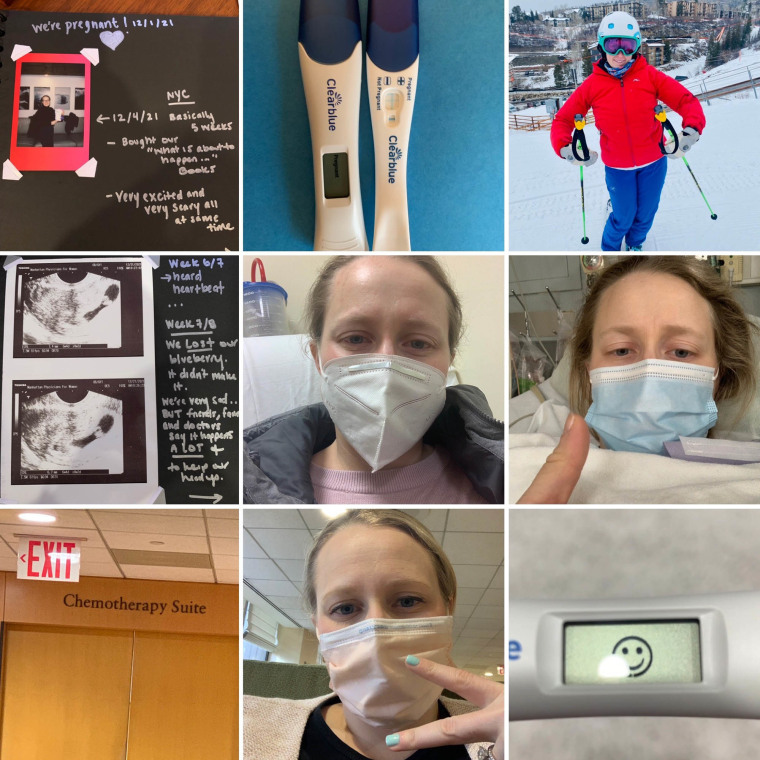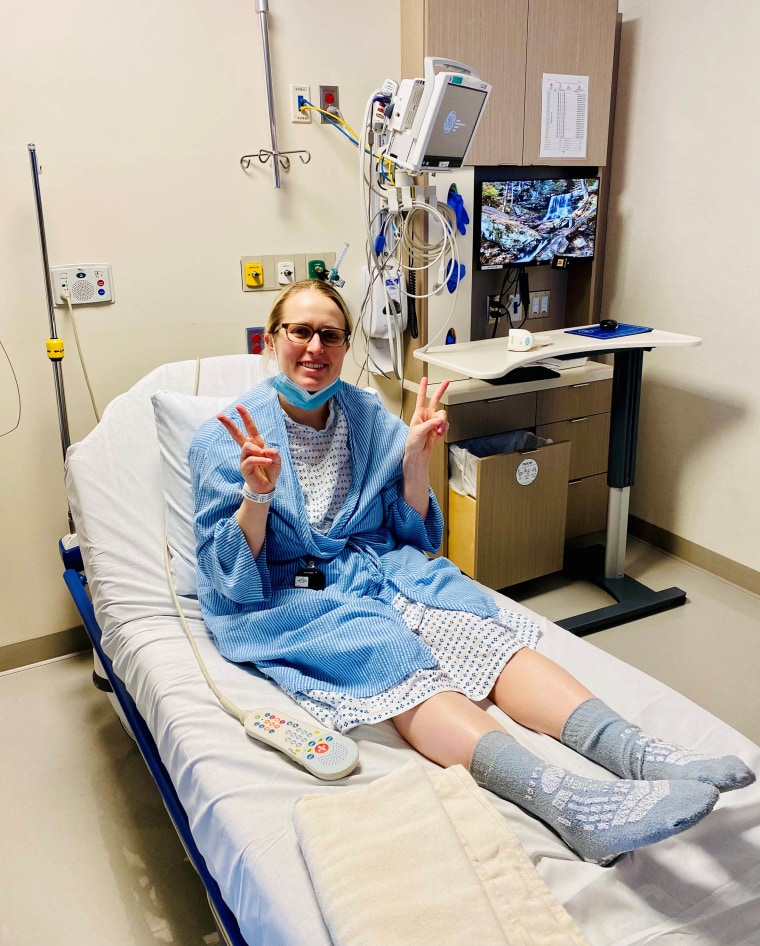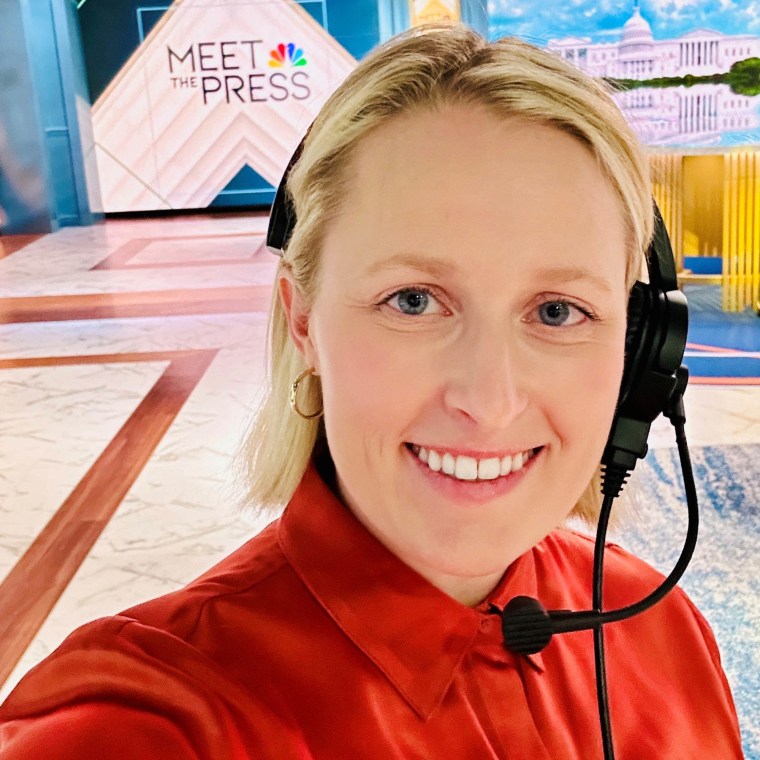Christine Schozer Farr, 34, works as a senior marketing manager at NBC News. Soon after her wedding, she became pregnant but miscarried, which happens in up to 20% of known pregnancies. Then, she developed a rare cancer related to her pregnancy.
The three years since have been complicated, painful and filled with challenges, and her journey to parenthood is still ongoing. She’s sharing her story to help other women and families who may be experiencing something similar and offer them knowledge and support.
After marrying in June 2021, I became pregnant in November of that year, when I was 30. We were excited and told my family at seven weeks, following a positive screening, where we saw a flicker of the heartbeat on the ultrasound. Sadly, when I returned to the doctor after Christmas, there was no longer a heartbeat at eight weeks — I had miscarried.
I underwent two dilation and curettages, also known as a D&C. Doctors believed they removed all the tissue and told me that after my menstrual cycle returned, my husband and I could try to get pregnant again.
My OB-GYN continued checking my blood work, but the levels of my hCG, a hormone secreted by the placenta during pregnancy, remained elevated, despite the fact that I was no longer pregnant. My menstrual cycle never returned either. My doctor felt worried by these results and continued close monitoring.
In March 2022, my bloodwork was still picking up some hCG, so my doctor decided to order an ultrasound, which found a mass in my uterus. They determined I had experienced a partial molar pregnancy, when two sperm fertilize one egg, resulting in too many chromosomes, as the Cleveland Clinic explains it. In a partial molar pregnancy, the embryo forms incorrectly or fails to develop at all and ends in miscarriage.

Normally, a D&C is all that’s needed to treat a molar pregnancy, but in my case, the embryo had rooted into the wall of my uterus and grew into a mass, keeping my hCG levels elevated. Several doctors said this finding was “interesting,” which is never a word you want to hear about your health. Immediately, my OB-GYN referred me to Memorial Sloan Kettering Cancer Center, where I met my oncologist, Dr. Ying Liu.
I learned I had gestational trophoblastic disease, a rare condition where tumors start in pregnancy and can become cancerous. My presentation was unusual, but Dr. Liu treated me with low-level doses of chemotherapy to kill the cells that developed. Every other week throughout April and May 2022, I received treatment.
Luckily, it seemed as if it worked. Finally, my hCG levels returned to zero, and doctors believed they had successfully treated my gestational trophoblastic disease. For the next six months, they monitored me, and I took birth control — I couldn’t get pregnant right away because of the recent rounds of chemotherapy.
At the end of the monitoring period, in November 2022, my doctor performed scans of my uterus. There was a scab where the mass had formed, but everything else was clear, and they told us we could try to start our family again.
After trying for five months with zero progress, we became frustrated, and by the summer of 2023, we pursued in vitro fertilization.
Prior to my undergoing an embryo transfer, doctors found that scar tissue had developed in my uterus that needed to be cleaned out using a standard procedure called a hysteroscopy, which they did in September 2023. Even though everything appeared normal, my doctor sent the scar tissue to be biopsied. The results revealed that I had something called atypical placental site nodules.
I soon learned how serious my condition was. Dr. Liu called me while I was on my way to a wedding and said the nodules were related to a very dangerous type of cancer called epithelioid trophoblastic tumor (ETT). She couldn’t determine if I had ETT, but it seemed possible the cells could turn into ETT, and my best option was to treat it with a hysterectomy, when the uterus is surgically removed.
At first I tried to hold it in, but then I burst into tears in the car. I was facing losing my fertility, and that’s a hard pill to swallow. But I also realized that my life was more important than carrying a baby, so I agreed to a hysterectomy. I requested one more round of egg retrievals before undergoing my hysterectomy in December 2023. When the pathology report came in, it confirmed that I had Stage 1 ETT.
It was wild because I was both diagnosed with cancer and declared cancer-free in that one call. But I felt glad I proactively addressed my health and agreed to a hysterectomy, even though that meant I will not be able to carry my own baby. At times, I still can’t believe that getting pregnant caused me to develop cancer.
How my pregnancy gave me cancer
Gestational trophoblastic disease occurs when tumors develop during pregnancy, Dr. Liu says. Because a partial molar pregnancy is not viable, it is considered a tumor and a form of gestational trophoblastic disease. While a partial molar pregnancy isn’t cancerous, doctors need to remove it with a D&C, and in rare cases, partial molar pregnancies can develop into cancer.
For example, my partial molar pregnancy caused me to develop atypical placental site nodules (APSN) — which my OB-GYN and Dr. Liu knew needed further, serious investigation.
“The APSN is not considered cancerous, but it’s considered an atypical finding that is suspicious because it’s often associated with ETT, epithelial trophoblastic tumors,” Liu, a gynecological medical oncologist and clinical geneticist at Memorial Sloan Kettering Cancer Center, explains.

When my doctors first looked at my biopsy, they couldn’t tell if there was ETT present, so the only way to know for sure was to do a hysterectomy.
ETT “can be very aggressive,” and they hide in the body for years, Dr. Liu says.
“We’ve had cases of patients whose pregnancies were five, 10, even 20 years ago, and later on, they present with ETT that already spread through the body. Once it’s spread, it’s very hard to treat,” she adds.
That’s why finding it early and removing the uterus is important in managing this type of cancer. Even though ETTs are aggressive, they’re uncommon.
“The most important thing to remember about these diseases is that they exist, but they’re very rare,” Dr. Liu says. “Each story is individual, and they really need specialized treatment at a center that has experience.”
If doctors catch ETT early and perform a hysterectomy, the likelihood of recurrence is low.
While there is a possibility that ETT can come back, it’s less likely in my case because it was found so early. I’m still being monitored carefully, with regular bloodwork and yearly imaging to be cautious and assured in my health.
Most people with ETT undergo monitoring for years to be confident “that the cancer does go away,” Dr. Liu says.
Helping others feel less alone
Throughout this journey, I’d try to look for stories or information about these conditions, and I found little about them outside of medical journals. That motivated me to share my story.
I hope that others do not feel as alone or frightened if they learn they have a molar or partial molar pregnancy, gestational trophoblastic disease or ETT because they’re able to read about my experience and know there are solutions.
Many women deal with issues caused by pregnancy at so many different stages, whether it’s conceiving, IVF, during pregnancy, or after birth, all of which are physically and mentally draining. I hope my story adds to the ongoing conversation around women’s reproductive rights and health care.

Since becoming pregnant, my life feels like a roller coaster. I went from being super excited to grieving my miscarriage. I remember looking at my husband after learning of the miscarriage, feeling shocked and devastated.
Still, I tried being positive even through the D&Cs, hoping we could start a family. But then issues kept happening. At one point, I knew in my gut that starting my family wouldn’t go as planned. In my case, I had to choose my life first so that, one day, I could be there for our children. In a way, we are lucky. I have my family and friends’ support along with phenomenal doctors like my OB-GYN, fertility doctor and Dr. Liu, who stuck with me throughout the process.